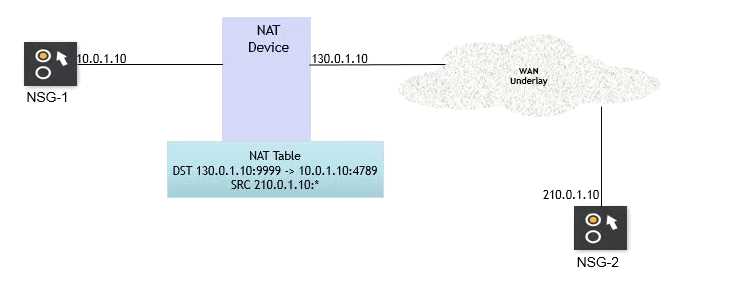nokia 4A0-N02 Exam Questions
Questions for the 4A0-N02 were updated on : Nov 21 ,2025
Page 1 out of 3. Viewing questions 1-15 out of 40
Question 1
Which of the following statements about the SD-WAN portal is TRUE?
- A. The SD-WAN portal is an optional addition to the Nuage Networks VNS solution.
- B. The SD-WAN portal cannot be deployed as a high availability cluster.
- C. The SD-WAN portal is configured either by the Graphical User Interface (GUI) or a Command Line Interface (CLI).
- D. The SD-WAN portal cannot be used to bootstrap NSGs.
Answer:
A
Question 2
Which protocol is used between VSAP and the VSC?
- A. XMPP
- B. OpenFlow
- C. BGP and OSPF or ISIS
- D. SNMP
Answer:
D
Question 3
Which of the following statements about the Nuage Networks SD-WAN portal is TRUE?
- A. It runs directly on any Linux-based bare metal server.
- B. It is packaged as a docker container.
- C. It is deployed as a KVM, Hyper-V or ESXi virtual machine.
- D. It must be hosted in a public cloud such as AWS.
Answer:
A
Question 4
Which Nokia product is the core component of VNO?
- A. Cloudband Network Director (CBND)
- B. CloudBand Application Manager (CBAM)
- C. CloudBand Infrastructure Software (CBIS)
- D. Nuage Networks Virtualized Services Directory (VSD)
Answer:
B
Question 5
Which of the following is NOT a VSAP web application?
- A. Service Navigator
- B. Security Management
- C. Inventory Management
- D. Fault Management
Answer:
A
Question 6
Which statement regarding the forwarding policies used in VNS for traffic redirection (also known as
service chaining) is FALSE?
- A. Forwarding policies can be applied to ingress and egress traffic.
- B. Redirection targets should be created in advance and associated with vports.
- C. Redirection targets cannot be associated with bridge vports (physical appliances).
- D. Traffic between two branch offices or between two devices in the same branch office can be redirected to an appliance located in the data center.
Answer:
D
Question 7
Which of the following statements about the NSG support for NAT-T is TRUE?
- A. NAT-T is a network port level attribute.
- B. NAT-T NPM probes are disabled by default.
- C. Direct Symmetric to Symmetric mapping is supported.
- D. Address restricted mapping requires the use of two NPM probes.
Answer:
A
Question 8

Which of the NAT-T variants creates a NAT table similar to the diagram?
- A. Symmetric mapping
- B. Port restricted mapping
- C. Address restricted mapping
- D. Endpoint-independent mapping
Answer:
C
Question 9
Which of the following statements is NOT correct about the communication between two NSGs in
different branch offices?
- A. These two NSGs exchange OpenFlow-TLS with their controller to establish the tunnel for overlay traffic.
- B. These two NSGs must be managed by the same VSD/VSD HA cluster.
- C. The overlay tunnels established between the NSGs must be VXLAN encapsulation.
- D. The overlay tunnels are established during bootstrapping.
Answer:
C
Question 10
Which of the following is NOT defined in the NSG infrastructure G/W profile?
- A. Identify the VSD proxy
- B. Enable two-factor installer authentication
- C. Port speed and mode
- D. NTP, stats, syslog server
Answer:
B
Question 11
Which of the following is TRUE about NSG dual uplink?
- A. It only provides redundancy for data traffic.
- B. Traffic is load balanced between primary and secondary links.
- C. One primary VSC is selected on each uplink.
- D. Both uplinks can be connected to the same network or to two different networks.
Answer:
B
Question 12
Which of the following statements about the NSG vports is TRUE?
- A. The NSG responds to DHCP requests on a host vport by default.
- B. A host MAC address is dynamically leaned on a host vport.
- C. A host vport allows multiple devices to be connected through a switch.
- D. IP address assignment is handled by the NSG for a host on a host vport.
Answer:
D
Question 13
Which one of the following statements is correct regarding bridge vPorts in the VNS solution?
- A. A DHCP pool can be configured on a subnet connected to an NSG bridge vPort, the NSG then becomes the DHCP server.
- B. VSD is in charge of the IP address assignment to the devices behind the NSG vPort.
- C. There must be more than one device behind the bridge vPort.
- D. The static IP to MAC mapping configuration is not on the bridge vPort.
Answer:
A
Question 14
Which of the following is FALSE regarding VNS bootstrapping?
- A. The bootstrapping configuration templates on VSD ensures NSG configuration conformance.
- B. NSG is ready for dispatch without prior configuration.
- C. It solves the problem of site CPE activation without having to send a skilled technician on site.
- D. NSG exchanges the plain text proprietary bootstrap protocol with VSD.
Answer:
D
Question 15
What type of NAT is used so that any external host can send to iAddr: iPort by sending traffic to
eAddr: ePort? (i=internal, e=external)
- A. Full-cone NAT
- B. Address-restricted NAT
- C. Port-restricted NAT
- D. Symmetric NAT
Answer:
A